Portraits de Louis-Charles et de Mme Sophie, alors nourrissons, par Vigée Le Brun...ou pas ?!
4 participants
LE FORUM DE MARIE-ANTOINETTE :: La famille royale et les contemporains de Marie-Antoinette :: Sa famille française :: Les enfants de Marie-Antoinette
Page 2 sur 2
Page 2 sur 2 •  1, 2
1, 2
 Re: Portraits de Louis-Charles et de Mme Sophie, alors nourrissons, par Vigée Le Brun...ou pas ?!
Re: Portraits de Louis-Charles et de Mme Sophie, alors nourrissons, par Vigée Le Brun...ou pas ?!
La nuit, la neige a écrit:
Seul le portrait du premier enfant est titré "bébé endormi", sans date.
Les autres sont datés qui plus est : approximativement pour le second, plus précisément pour les suivants.
Et la date ne correspond pas à celle de naissance de la petite Sophie.
Les date sont-elle finalement mentionnées sur ces dessins ?
Sont-ils titrés au dos ?
Oui, nous nous sommes étonnés ensemble .

Nous tenions tellement ces petits pour les Enfants de France ...
_________________
... demain est un autre jour .

Mme de Sabran- Messages : 55508
Date d'inscription : 21/12/2013
Localisation : l'Ouest sauvage
 Re: Portraits de Louis-Charles et de Mme Sophie, alors nourrissons, par Vigée Le Brun...ou pas ?!
Re: Portraits de Louis-Charles et de Mme Sophie, alors nourrissons, par Vigée Le Brun...ou pas ?!
La nuit, la neige a écrit:
Peut-être que depuis ta visite, des sources nouvelles sont venues contredire des attributions ?
Mystère !
En même pas trois mois, cela me paraît curieux... D'autant que lors de ma visite (fin juillet), j'imagine que l'inventaire des œuvres proposées pour l'expo devait être à peu près fait.
Si ce sont des enfants Lastic, et déclarés comme tels, la famille doit le savoir depuis toujours, non ? Dans ce cas, il n'y a pas eu de vente et donc impossibilité d'en ignorer la provenance : c'est grand-oncle bidule, c'est cousin machin... Comme d'autres Vigée-Lebrun (ou autres artistes connus) présentés.
Pourquoi subitement, redécouvrirait-on qu'ils sont Lastic et non de France ?
Ce n'est pas possible d'imaginer que oups, en déplaçant les dessins en vue de l'expo, on se soit aperçu des noms des enfants et des dates d'exécution ! Et de se tromper à ce point jusque-là !
Je ne peux douter de la bonne foi de monsieur de Lastic : impossible d'imaginer que lui ou son prédécesseur aient voulu faire croire "que"et de s'être ravisés une fois l'expo imminente. Ce serait trop grave. D'autant que les activités de ce monsieur concernent le monde de l'art. Sa crédibilité est inattaquable.
Donc j'aimerais vraiment avoir une explication.
D'autre part, que je sache madame Vigée-Lebrun n'avait pas l'habitude de peindre vite fait tous les bébés de ses multiples clients. Elle peint le couple Lastic en 1779. Elle n'en reparle pas dans ses mémoires, rien.
C'est autre chose que ce grand portrait en pied de la reine et de ses enfants, des études qu'elle doit effectuer pour saisir sa composition, des dessins préparatoires qu'elle fait des enfants royaux et de leur mère. Elle sait que de cette commande dépend tout le reste de sa carrière.
Les Lastic et leurs enfants...

Et en plus en 1787, elle fait des portraits des enfants royaux à l'attention de madame de Polignac.
Invité- Invité
 Re: Portraits de Louis-Charles et de Mme Sophie, alors nourrissons, par Vigée Le Brun...ou pas ?!
Re: Portraits de Louis-Charles et de Mme Sophie, alors nourrissons, par Vigée Le Brun...ou pas ?!
Pour moi je me tiens aux propos d'Olivia et ma pensée n'est pas à prendre à l'imparfaitMme de Sabran a écrit:
Nous tenions tellement ces petits pour les Enfants de France ...
Bien à vous.
Invité- Invité
 Re: Portraits de Louis-Charles et de Mme Sophie, alors nourrissons, par Vigée Le Brun...ou pas ?!
Re: Portraits de Louis-Charles et de Mme Sophie, alors nourrissons, par Vigée Le Brun...ou pas ?!
Mais les dates ?
Lorsqu'elles sont ignorées, elle ne sont pas mentionnées.
Comme c'est le cas pour ce premier portrait qui, lui, reste, pour l'instant, sans attribution.
Et qui est le petit Eugène de Montesquiou Fezensac ? boudoi32
Un rapport avec les Lastic ?
Il faut les contacter pour avoir le fin mot de l'histoire...
Car je pense, pour ma part, que les experts et/ou commissaires de l'exposition auraient plus volontiers laissé un titre "enfants de France" (même présumé) sous ces œuvres, non ?
Enfin bref, c'est très étonnant en effet...
Lorsqu'elles sont ignorées, elle ne sont pas mentionnées.
Comme c'est le cas pour ce premier portrait qui, lui, reste, pour l'instant, sans attribution.
Et qui est le petit Eugène de Montesquiou Fezensac ? boudoi32
Un rapport avec les Lastic ?
Il faut les contacter pour avoir le fin mot de l'histoire...

Car je pense, pour ma part, que les experts et/ou commissaires de l'exposition auraient plus volontiers laissé un titre "enfants de France" (même présumé) sous ces œuvres, non ?
Enfin bref, c'est très étonnant en effet...
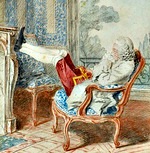
La nuit, la neige- Messages : 18137
Date d'inscription : 21/12/2013
 Re: Portraits de Louis-Charles et de Mme Sophie, alors nourrissons, par Vigée Le Brun...ou pas ?!
Re: Portraits de Louis-Charles et de Mme Sophie, alors nourrissons, par Vigée Le Brun...ou pas ?!
La nuit, la neige a écrit:
Car je pense, pour ma part, que les experts et/ou commissaires de l'exposition auraient plus volontiers laissé un titre "enfants de France" (même présumé) sous ces œuvres, non ?
C'est ce qui me semble aussi .
La nuit, la neige a écrit:
Enfin bref, c'est très étonnant en effet...
... très oui !

Mais ce ne fut pas le grand choc qui m'a presque assise, à Schönbrunn, quand j'ai lu Marie-Joseph sous le tableau que vous savez ...
_________________
... demain est un autre jour .

Mme de Sabran- Messages : 55508
Date d'inscription : 21/12/2013
Localisation : l'Ouest sauvage
 Re: Portraits de Louis-Charles et de Mme Sophie, alors nourrissons, par Vigée Le Brun...ou pas ?!
Re: Portraits de Louis-Charles et de Mme Sophie, alors nourrissons, par Vigée Le Brun...ou pas ?!
Je reviens sur....
 Je reviens donc sur ces attributions avec une nouvelle information communiquée sur le site internet du château de Parentignat (propriété de la famille Lastic) et qui concerne l'un de ces enfants endormis.
Je reviens donc sur ces attributions avec une nouvelle information communiquée sur le site internet du château de Parentignat (propriété de la famille Lastic) et qui concerne l'un de ces enfants endormis.
Je cite :
D’après les archives de la famille, cet enfant serait le premier né du couple formé par Louise-Hyacinthe de Montesquiou et Anne-François V de Lastic. La jeune mariée fut dame d’honneur de la soeur du Roi Louis XVI, ce qui explique le lien avec l’artiste Elisabeth Vigée Le Brun, portraitiste officielle de la Cour.

Étude d’un enfant de la famille de Lastic Sieujac endormi sur un coussin
Elisabeth Vigée Le Brun
Pastel, 1780-83
Image : Château de Parentignat
Nous retrouvons dans la " chambre Louis XV " du château les portraits des parents de cet enfant, peints par Vigée Le Brun

Image : Château de Parentignat

Portrait de la marquise de Lastic, née Anne-Louise-Hyacinthe-Augustine de Montesquiou-Fezensac (1761-1823)
Dame d'honneur de Madame Elisabeth
Elisabeth-Louise Vigée Le Brun
Pastel sur papier marouflé sur toile, 1779
Château de Parentignat
Image : Wikipedia

Anne-François V de Lastic, marquis de Lastic, marquis de Sieujac, vicomte de Murat (1759 - 1785)
Elisabeth-Louise Vigée Le Brun
18e siècle
Château de Parentignat
Image : Batguano.com
Selon les sites de généalogie, le couple aurait eut trois enfants Amédée de Lastic (1782-1788), François de Lastic (1783-1784) et Octavie de Lastic-Sieujac (1785-1861)
 L'autre enfant, de la série présentée ci-dessus, et identifié comme étant Eugène de Montesquiou-Fézensac (1782-1810), est donc le cousin de l'enfant ci-dessus (du côté de la mère).
L'autre enfant, de la série présentée ci-dessus, et identifié comme étant Eugène de Montesquiou-Fézensac (1782-1810), est donc le cousin de l'enfant ci-dessus (du côté de la mère).

Eugène de Montesquiou Fezensac, à l'âge de cinq mois, endormi sur un coussin
Elisabeth-Louise Vigée Le Brun
Pastel sur papier, 1783
Image : VivelaReine
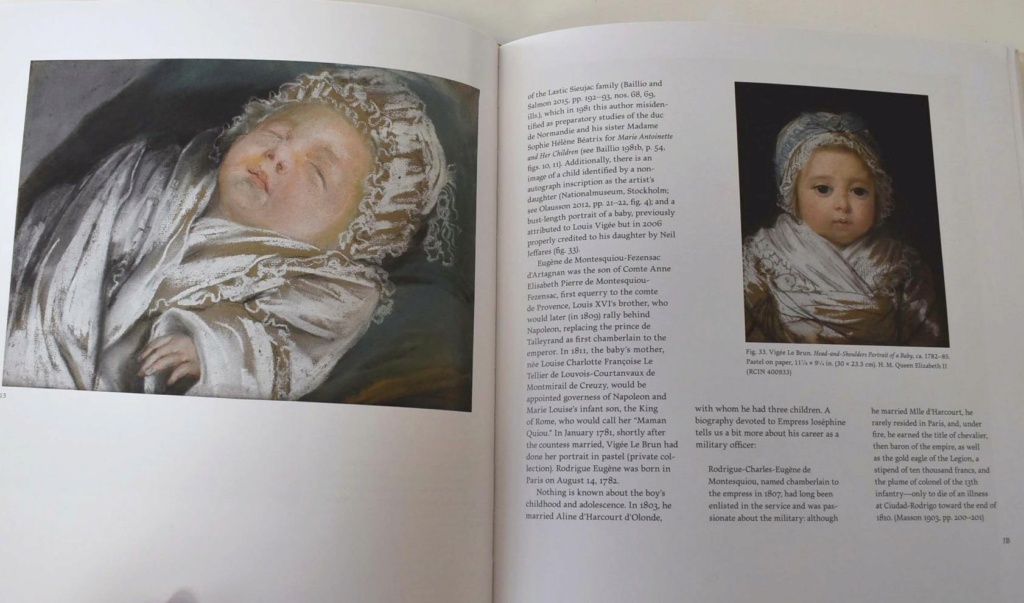
Extrait du catalogue Vigée Le Brun de K.Baetjer (Auteur), J. Baillio, P. Lang (2016)
La nuit, la neige a écrit:Nous avons donc pu voir ces petits portraits à l'exposition Vigée Le Brun (Grand Palais).
En effet, les notes des experts écartent la possibilité que ces portraits soient ceux des enfants de Marie-Antoinette, je cite :
Ces études représentent des nourrissons coiffés de bonnets et emmaillotés dans des fichus ou des langes. Exécutés dans la première moitié des années 1780, elles témoignent de la profonde influence de Jean-Jacques Rousseau. Sans doute la publication du premier livre de l'Emile, où le philosophe soulignait la nécessité de porter attention aux enfants "dès l'âge de la nature" n'est pas étrangère à l'intérêt artistique que montrèrent alors certains peintres pour de très jeunes modèles. En effet, après la parution de ce véritable traité d'éducation, tout à la fois pragmatique et visionnaire, la représentation de nouveaux-nés se multiplia.
Bébé endormi
(non daté)
Pierre noire, sanguine et craie blanche, estompe, sur papier beige
Collection particulière
Etude d'un enfant de la famille de Lastic Sieujac endormi sur un coussin
Vers 1780-83
Pastel sur papier
Collection particulière
Eugène de Montesquiou Fezensac, à l'âge de cinq mois, endormi sur un coussin
Janvier 1783
Pastel sur papier
Collection particulière
Etude d'un enfant de la famille de Lastic Sieujac
1783
Pastel sur papier marouflé sur toile
Collection particulière
Je cite :
D’après les archives de la famille, cet enfant serait le premier né du couple formé par Louise-Hyacinthe de Montesquiou et Anne-François V de Lastic. La jeune mariée fut dame d’honneur de la soeur du Roi Louis XVI, ce qui explique le lien avec l’artiste Elisabeth Vigée Le Brun, portraitiste officielle de la Cour.

Étude d’un enfant de la famille de Lastic Sieujac endormi sur un coussin
Elisabeth Vigée Le Brun
Pastel, 1780-83
Image : Château de Parentignat
Nous retrouvons dans la " chambre Louis XV " du château les portraits des parents de cet enfant, peints par Vigée Le Brun

Image : Château de Parentignat

Portrait de la marquise de Lastic, née Anne-Louise-Hyacinthe-Augustine de Montesquiou-Fezensac (1761-1823)
Dame d'honneur de Madame Elisabeth
Elisabeth-Louise Vigée Le Brun
Pastel sur papier marouflé sur toile, 1779
Château de Parentignat
Image : Wikipedia

Anne-François V de Lastic, marquis de Lastic, marquis de Sieujac, vicomte de Murat (1759 - 1785)
Elisabeth-Louise Vigée Le Brun
18e siècle
Château de Parentignat
Image : Batguano.com
Selon les sites de généalogie, le couple aurait eut trois enfants Amédée de Lastic (1782-1788), François de Lastic (1783-1784) et Octavie de Lastic-Sieujac (1785-1861)

Eugène de Montesquiou Fezensac, à l'âge de cinq mois, endormi sur un coussin
Elisabeth-Louise Vigée Le Brun
Pastel sur papier, 1783
Image : VivelaReine

Extrait du catalogue Vigée Le Brun de K.Baetjer (Auteur), J. Baillio, P. Lang (2016)

La nuit, la neige- Messages : 18137
Date d'inscription : 21/12/2013
 Re: Portraits de Louis-Charles et de Mme Sophie, alors nourrissons, par Vigée Le Brun...ou pas ?!
Re: Portraits de Louis-Charles et de Mme Sophie, alors nourrissons, par Vigée Le Brun...ou pas ?!
Ces portraits sont délicieux, pleins de quiétude et d'abandon ... 

_________________
... demain est un autre jour .

Mme de Sabran- Messages : 55508
Date d'inscription : 21/12/2013
Localisation : l'Ouest sauvage
 Re: Portraits de Louis-Charles et de Mme Sophie, alors nourrissons, par Vigée Le Brun...ou pas ?!
Re: Portraits de Louis-Charles et de Mme Sophie, alors nourrissons, par Vigée Le Brun...ou pas ?!
Le portrait de l'enfant, visible sur la seconde page du catalogue photographié ci-dessus, demeure celui d'un(e) inconnu(e).
Nous ne l'avions pas vu à l'expo EVLB, au Grand Palais (2015). Il était resté dans les collections de sa majesté Elizabeth II, où il est présenté comme le " portrait d'un enfant " :
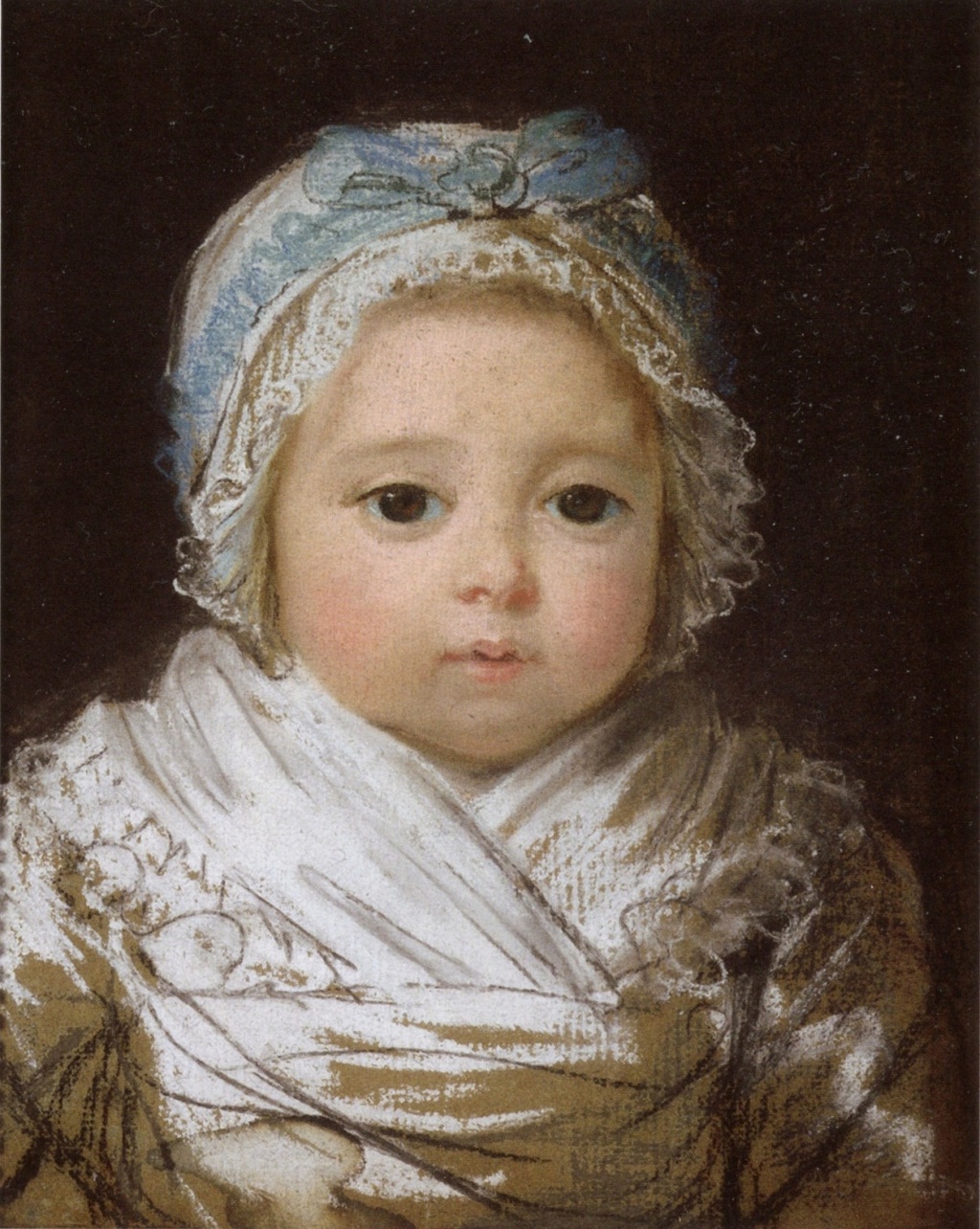
Portrait of a child
Elisabeth-Louise Vigée Lebrun
Pastel on paper, c. 1785
30.0 x 23.3 cm (sight)
Description :
Nothing is known of the provenance of this charming pastel before it appeared at Windsor Castle in the 19th century. It is inscribed on the reverse ‘Mme Le brun née Vigée a l'age de 3 ans [crossed out for ‘mois’] peint par M Vigée Son Pere’ (‘Madame Le Brun, née Vigée, when 3 years old [crossed out for ‘less’], painted by her father, M. Vigée’). This note lead to the traditional attribution to Louis Vigée (1715-67), a minor pastel painter. The style of the work does not match his and the date of c. 1757 (if it is to be a portrait of his infant daughter) does not correspond to the costume seen here.
More recently the attribution to Élisabeth Vigée Le Brun has been proposed with a date of c. 1783, by analogy with other documented pastels of children by her (see Élisabeth Vigée Le Brun, 2015-6 exhibition at the Metropolitan Museum, New York. (C'est à dire les portraits "Lastic ou Montesquiou" présentés ci-dessus).
Nous ne l'avions pas vu à l'expo EVLB, au Grand Palais (2015). Il était resté dans les collections de sa majesté Elizabeth II, où il est présenté comme le " portrait d'un enfant " :

Portrait of a child
Elisabeth-Louise Vigée Lebrun
Pastel on paper, c. 1785
30.0 x 23.3 cm (sight)
Description :
Nothing is known of the provenance of this charming pastel before it appeared at Windsor Castle in the 19th century. It is inscribed on the reverse ‘Mme Le brun née Vigée a l'age de 3 ans [crossed out for ‘mois’] peint par M Vigée Son Pere’ (‘Madame Le Brun, née Vigée, when 3 years old [crossed out for ‘less’], painted by her father, M. Vigée’). This note lead to the traditional attribution to Louis Vigée (1715-67), a minor pastel painter. The style of the work does not match his and the date of c. 1757 (if it is to be a portrait of his infant daughter) does not correspond to the costume seen here.
More recently the attribution to Élisabeth Vigée Le Brun has been proposed with a date of c. 1783, by analogy with other documented pastels of children by her (see Élisabeth Vigée Le Brun, 2015-6 exhibition at the Metropolitan Museum, New York. (C'est à dire les portraits "Lastic ou Montesquiou" présentés ci-dessus).

La nuit, la neige- Messages : 18137
Date d'inscription : 21/12/2013
 Re: Portraits de Louis-Charles et de Mme Sophie, alors nourrissons, par Vigée Le Brun...ou pas ?!
Re: Portraits de Louis-Charles et de Mme Sophie, alors nourrissons, par Vigée Le Brun...ou pas ?!
J'avoue être un tout tout tout petit peu déçue de ne plus voir dans ces portraits les Enfants de France ... 

_________________
... demain est un autre jour .

Mme de Sabran- Messages : 55508
Date d'inscription : 21/12/2013
Localisation : l'Ouest sauvage
 Re: Portraits de Louis-Charles et de Mme Sophie, alors nourrissons, par Vigée Le Brun...ou pas ?!
Re: Portraits de Louis-Charles et de Mme Sophie, alors nourrissons, par Vigée Le Brun...ou pas ?!
Confirmation de ce que nous avions déjà annoncé dès la page 1 de ce sujet, à savoir que les charmants bambins de ces portraits NE SONT PAS ceux des enfants de Marie-Antoinette 

Et ainsi, par exemple, de la page Wikipedia de Sophie de France (1786-1787) qui affiche toujours les mauvais portraits en illustration de la biographie de la princesse...
 Seront donc prochainement présentés en vente aux enchères :
Seront donc prochainement présentés en vente aux enchères :
Élisabeth Louise Vigée Le Brun
Portrait of a Sleeping Infant
Black, red and white chalk with stumping
320 by 250 mm (sight size)
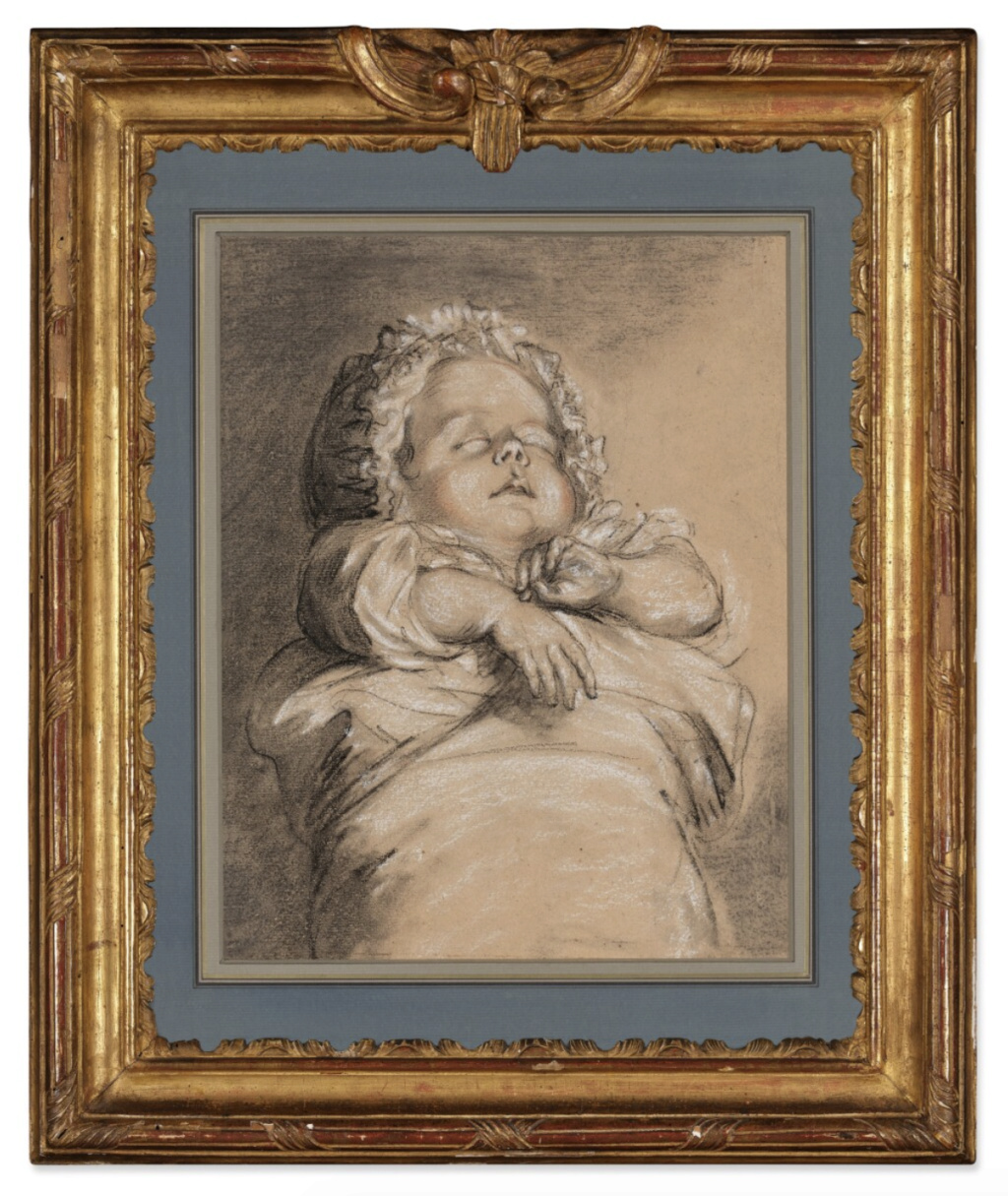
Catalogue Note
The sleeping baby in this portrait, executed circa 1783, has not been identified, but as Joesph Baillio aptly points out, he ‘is so similar in pose and composition to Lot 7 (portrait à suivre) that they could be studies of the same little boy.’(1)
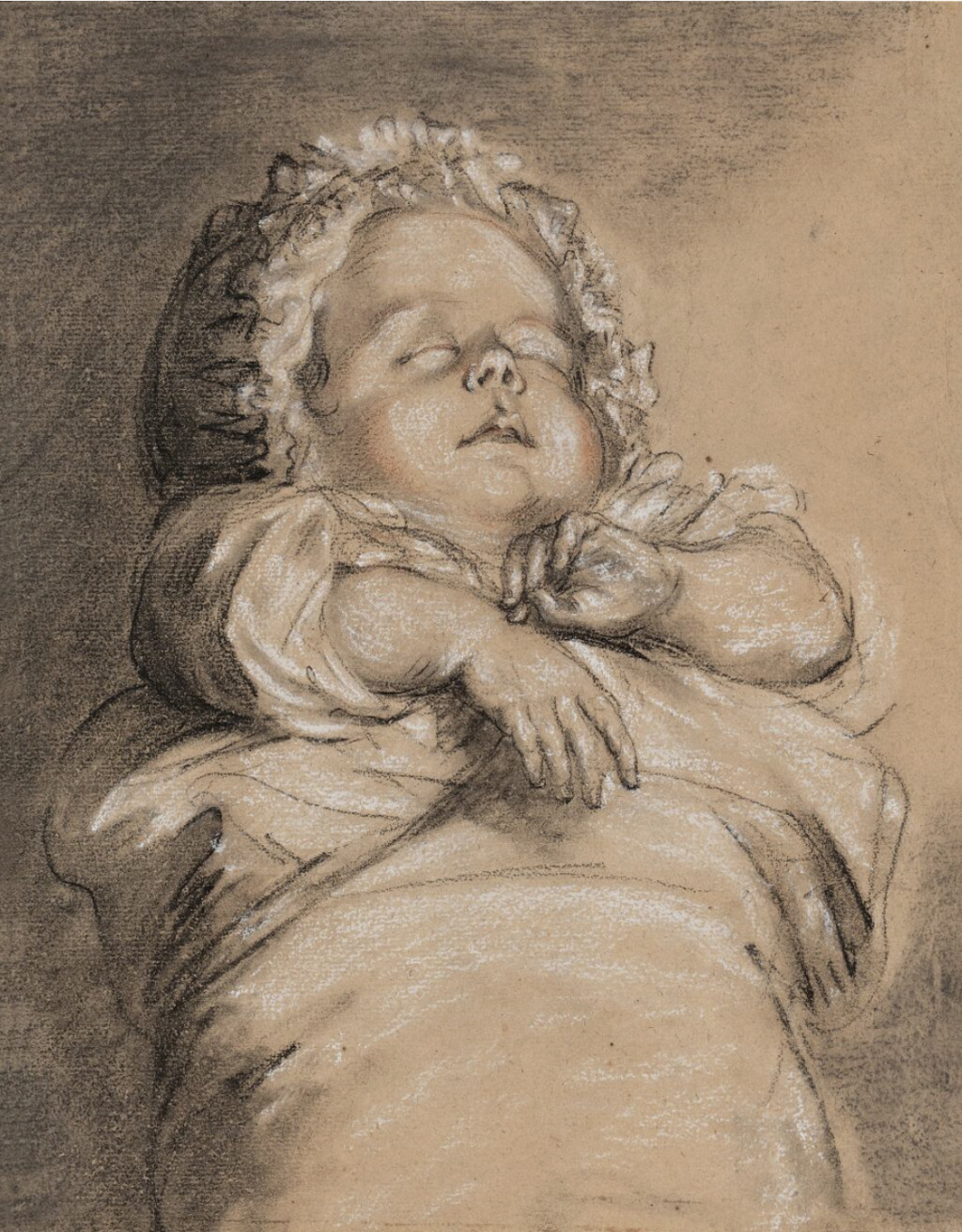
Like lot 27 (portrait à suivre), this study has been rendered in a combination of red, black and white chalk. The baby is portrayed in a vertical format, swaddled in a blanket and wearing a bonnet with frills and lace. Just as in lot 7, the child is deep in slumber, his hands slightly raised above his chest. The fingers of his left hand lightly touch his thumb, while the other hand hangs over the blanket’s fold. Madame Vigée’s careful observations and attention to detail lend a striking vividness to this sweet and tender portrait; the viewer is faced with the little up-turned nose of the baby and the plumpness of the ruddy cheeks, flushed from sleep.

Note
1. J. Baillio, P. Lang and K. Baetjer, Elisabeth Louise Vigée Le Brun, exh. cat., New York and Ottawa 2016, p. 83, under cat. 15
Élisabeth Louise Vigée Le Brun
The Little Eugène de Montesquiou-Fézensac Asleep
Pastel 205 by 298 mm
Provenance :
Commissioned by (or offered by the artist to) the child's mother, the comtesse de Montesquiou Fezensac, née Louise-Charlotte-Françoise Le Tellier de Louvois-Courtanvaux de Montmirail de Creuzy (1765-1835), Paris and Château de Courtanvaux; Thence by descent to her son, comte Ambroise Anatole Augustin de Montesquiou-Fézensac (1788-1878) (...)
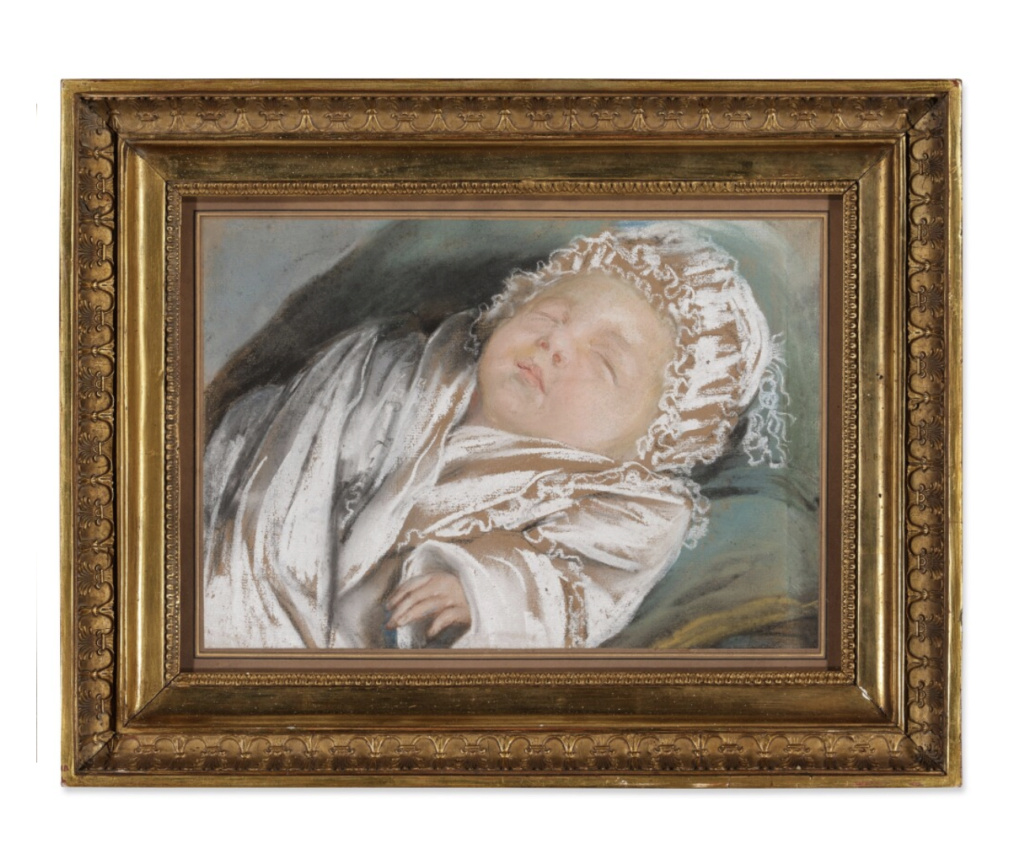
Catalogue Note
The present portrait and lots 27 (à suivre) and 29 (ci-dessus) represent some of the most tender and moving depictions of young children in French eighteenth-century art.

The infant portrayed here, asleep, swaddled in a white baby garment and wearing a lace bonnet, is Eugène de Montesquiou-Fézensac. Born in 1782, he is barely a year old. Vigée Le Brun’s technical mastery of the pastel medium is manifested in the dexterous handling of the chalks, simultaneously creating rough and smooth textures. The ruffles and texturing on the lace contrast with the smoothness of the baby’s skin. Economical use of line is cleverly employed to illustrate that his eyes are closed in peaceful slumber, while his little raised hand is suggestive of the dreams that may animate his limbs during rest. It is perfectly observed, by an artist who is herself at this date very familiar with a young child’s physiognomy and nature; Madame Vigée Le Brun’s only daughter, Julie Le Brun, was three years old when this portrait was likely commissioned.
While children have always been popular subjects for works of art, a particular interest in depicting very young children was ignited, amongst artists in eighteenth-century France, by the publication of Jean-Jacques Rousseau’s book, Émile (1762), in which Rousseau emphasized the importance of keenly observing children during their ‘age of nature.’(1) Joseph Baillio, in his 2016 catalogue entry for this pastel (see Exhibited) refers to this burgeoning interest in the very young model, citing the examples of two wash drawings of newborns by Moreau Le Jeune and the superb drawing of the King of Rome sleeping (1811), by Pierre Paul Prud’hon, in the Musée du Louvre.(2) Madame Le Brun was no stranger to the use of young children as models for artists; from a young age, she too was depicted by her own father, Louis Vigée, who executed a pastel portrait of her, circa 1760-1.(3)
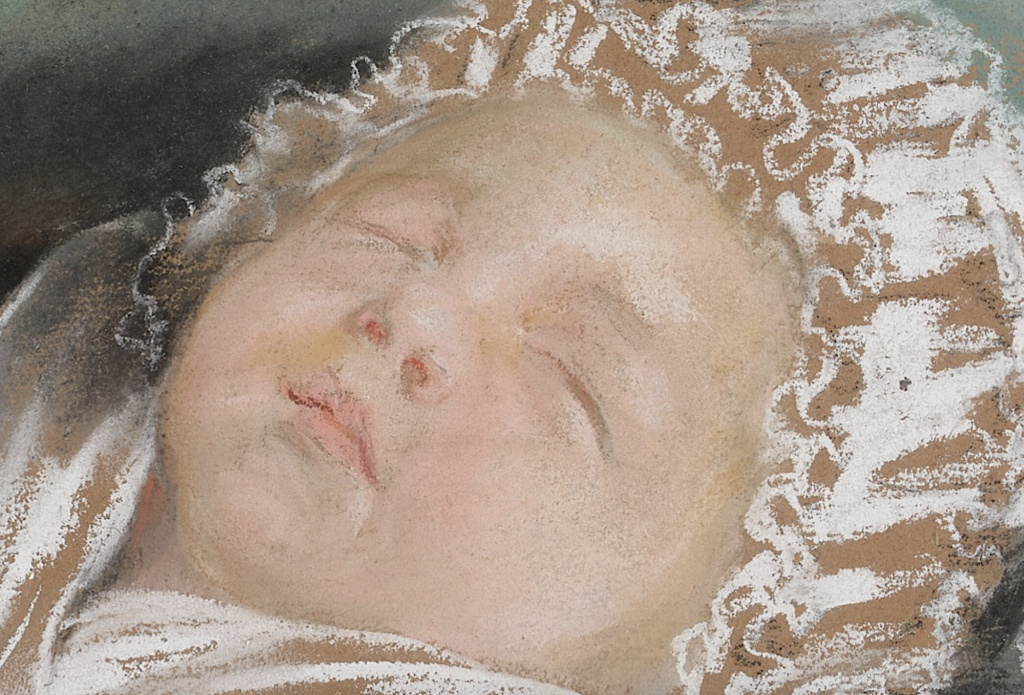
The son of the Comte Anne-Elisabeth-Pierre de Montesquiou-Fézensac and Louise-Charlotte-Françoise Le Tellier de Courtanvaux, Eugène de Montesquiou-Fézensac d’Artagnan was to become first equerry to the comte de Provence, Louis XVI’s brother, who would later (in 1809) rally to the side of Napoleon, replacing the prince de Talleyrand as First Chamberlain to the emperor.(4) Several years earlier, in 1780, Madame Le Brun produced a pastel portrait of Eugène’s mother, now in a private collection.(5) There is little information about the young boy’s childhood but in 1803 he married Aline d’Harcourt d’Olonde and they had three children together.
Other portraits of young infants by Vigée Le Brun, also executed in the 1780s, include images of Eugène's two Lastic-Sieujac cousins.(6)
This pastel and the trois-crayons drawing of a Sleeping baby (lot 29), which may also depict the same child, are both serene images, our appreciation of which is only heightened by the knowledge that, unlike adult sitters who are acutely aware that their portrait is being made, each is totally oblivious to the fact that they are being studied. The empathetic dialogue in all three portraits (Lots 7, 27 and 29) may, in part, be due to their execution coinciding with the birth of Vigee Le Brun’s own daughter, in 1780, and with the unfortunate miscarriage of her second pregnancy in 1784.

Madame Vigée-Le Brun et sa fille, Jeanne-Lucie-Louise, dite Julie (1780-1819)
Louise-Elisabeth Vigée Le Brun
Huile sur bois, 1786
Signature : S.D.h.d.: "Louis Vigée Le Brun f. 1786"
Image : RMN Grand Palais, musée du Louvre
Notes
1 J. Baillio, P. Lang and K. Baetjer, Elisabeth Louise Vigée Le Brun, exh. cat., New York and Ottawa 2016, p. 83, under cat. 15
2 Ibid
3 Ibid., p. 4, fig. 1
4 Ibid., p. 85, under cat. 15
5 J. Baillio and X. Salmon, Élisabeth Louise Vigée Le Brun, exh. cat., Paris 2015, p. 217, cat. 87, reproduced
6 Ibid., pp. 192-3, cats. 68 and 69
Élisabeth Louise Vigée Le Brun
Portrait of a Little Girl
Register to Bid
Lot Details
Description
Élisabeth Louise Vigée Le Brun
Paris 1755 - 1842
Portrait of a Little Girl
black, red and blue chalk, heightened with white chalk and stumping
249 by 247 mm (sight size)
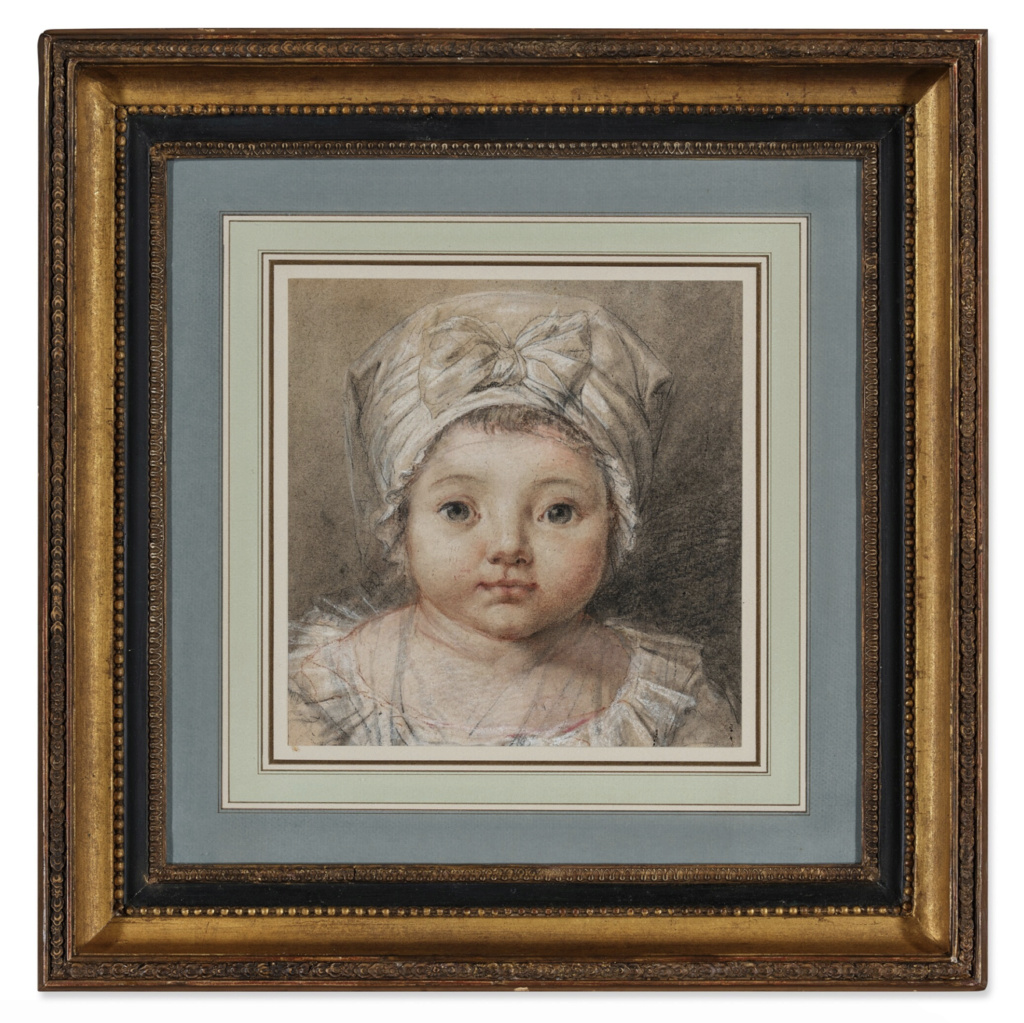
Catalogue Note
The young girl depicted here, head and shoulders and looking out at the viewer, has not been identified. Her blue eyes are wide and her cheeks plump and flushed; she is dressed in a white frilly garment, only the collar of which is visible, and she wears a bonnet adorned with a bow. As in the portrait of the sleeping baby (lot 29), Madame Le Brun has built her image with chalks of three colors: red, black and white – the time-honoured trois crayons technique so beloved of French artists, especially in the eighteenth century, with the addition of blue pastel for the eyes of the child. The textures are tangible, the lines of chalk used to create ruffles and pleats in the little girl’s clothing and bonnet. Accents in red chalk highlight her cheeks and mouth and also define the areas around her shoulders. The combination of strokes and rapidity of placement suggest a playfulness that is echoed in the slight smile gracing the child’s lips.

This wide-eyed innocence of youth is also to be found in a 1787 portrait, painted in oils by Mme Le Brun, depicting her own daughter, Julie.(1) The painting is an almost full-length portrait, in profile, of Julie holding a mirror.

Julie Le Brun (1780–1819) Looking in a Mirror
Elisabeth Louise Vigée Le Brun
Oil on canvas, 1787
Image : Metropolitan museum
The young girl’s face is only fully revealed in the reflection: her bright, inquisitive eyes, the roundness of her face and her pursed plump lips. It is a very beautiful and intimate portrait that reveals as much about the tenderness of motherhood as it does about the innocence of childhood. Madame Vigée excelled in capturing the unassuming and carefree nature of childhood in her studies of young children, both those of aristocratic families and her own.
A pastel portrait, of a slightly younger child, head and shoulders, executed circa 1782-85, is in the Royal Collection and yet another is in the Nationalmuseum, Stockholm.(2)

Notes :
1. J. Baillio, Élisabeth Louise Vigée Le Brun 1755-1842, exh. cat., Fort Worth 1982, p. 74, cat. 25
2. J. Baillio and X. Salmon, Élisabeth Louise Vigée Le Brun, exh. cat., Paris 2015, p. 192, fig. 1
* Source et infos complémentaires : Sotheby's - New York, vente du 31 janvier 2024
Et ainsi, par exemple, de la page Wikipedia de Sophie de France (1786-1787) qui affiche toujours les mauvais portraits en illustration de la biographie de la princesse...

Élisabeth Louise Vigée Le Brun
Portrait of a Sleeping Infant
Black, red and white chalk with stumping
320 by 250 mm (sight size)

Catalogue Note
The sleeping baby in this portrait, executed circa 1783, has not been identified, but as Joesph Baillio aptly points out, he ‘is so similar in pose and composition to Lot 7 (portrait à suivre) that they could be studies of the same little boy.’(1)

Like lot 27 (portrait à suivre), this study has been rendered in a combination of red, black and white chalk. The baby is portrayed in a vertical format, swaddled in a blanket and wearing a bonnet with frills and lace. Just as in lot 7, the child is deep in slumber, his hands slightly raised above his chest. The fingers of his left hand lightly touch his thumb, while the other hand hangs over the blanket’s fold. Madame Vigée’s careful observations and attention to detail lend a striking vividness to this sweet and tender portrait; the viewer is faced with the little up-turned nose of the baby and the plumpness of the ruddy cheeks, flushed from sleep.

Note
1. J. Baillio, P. Lang and K. Baetjer, Elisabeth Louise Vigée Le Brun, exh. cat., New York and Ottawa 2016, p. 83, under cat. 15
Élisabeth Louise Vigée Le Brun
The Little Eugène de Montesquiou-Fézensac Asleep
Pastel 205 by 298 mm
Provenance :
Commissioned by (or offered by the artist to) the child's mother, the comtesse de Montesquiou Fezensac, née Louise-Charlotte-Françoise Le Tellier de Louvois-Courtanvaux de Montmirail de Creuzy (1765-1835), Paris and Château de Courtanvaux; Thence by descent to her son, comte Ambroise Anatole Augustin de Montesquiou-Fézensac (1788-1878) (...)

Catalogue Note
The present portrait and lots 27 (à suivre) and 29 (ci-dessus) represent some of the most tender and moving depictions of young children in French eighteenth-century art.

The infant portrayed here, asleep, swaddled in a white baby garment and wearing a lace bonnet, is Eugène de Montesquiou-Fézensac. Born in 1782, he is barely a year old. Vigée Le Brun’s technical mastery of the pastel medium is manifested in the dexterous handling of the chalks, simultaneously creating rough and smooth textures. The ruffles and texturing on the lace contrast with the smoothness of the baby’s skin. Economical use of line is cleverly employed to illustrate that his eyes are closed in peaceful slumber, while his little raised hand is suggestive of the dreams that may animate his limbs during rest. It is perfectly observed, by an artist who is herself at this date very familiar with a young child’s physiognomy and nature; Madame Vigée Le Brun’s only daughter, Julie Le Brun, was three years old when this portrait was likely commissioned.
While children have always been popular subjects for works of art, a particular interest in depicting very young children was ignited, amongst artists in eighteenth-century France, by the publication of Jean-Jacques Rousseau’s book, Émile (1762), in which Rousseau emphasized the importance of keenly observing children during their ‘age of nature.’(1) Joseph Baillio, in his 2016 catalogue entry for this pastel (see Exhibited) refers to this burgeoning interest in the very young model, citing the examples of two wash drawings of newborns by Moreau Le Jeune and the superb drawing of the King of Rome sleeping (1811), by Pierre Paul Prud’hon, in the Musée du Louvre.(2) Madame Le Brun was no stranger to the use of young children as models for artists; from a young age, she too was depicted by her own father, Louis Vigée, who executed a pastel portrait of her, circa 1760-1.(3)

The son of the Comte Anne-Elisabeth-Pierre de Montesquiou-Fézensac and Louise-Charlotte-Françoise Le Tellier de Courtanvaux, Eugène de Montesquiou-Fézensac d’Artagnan was to become first equerry to the comte de Provence, Louis XVI’s brother, who would later (in 1809) rally to the side of Napoleon, replacing the prince de Talleyrand as First Chamberlain to the emperor.(4) Several years earlier, in 1780, Madame Le Brun produced a pastel portrait of Eugène’s mother, now in a private collection.(5) There is little information about the young boy’s childhood but in 1803 he married Aline d’Harcourt d’Olonde and they had three children together.
Other portraits of young infants by Vigée Le Brun, also executed in the 1780s, include images of Eugène's two Lastic-Sieujac cousins.(6)
This pastel and the trois-crayons drawing of a Sleeping baby (lot 29), which may also depict the same child, are both serene images, our appreciation of which is only heightened by the knowledge that, unlike adult sitters who are acutely aware that their portrait is being made, each is totally oblivious to the fact that they are being studied. The empathetic dialogue in all three portraits (Lots 7, 27 and 29) may, in part, be due to their execution coinciding with the birth of Vigee Le Brun’s own daughter, in 1780, and with the unfortunate miscarriage of her second pregnancy in 1784.

Madame Vigée-Le Brun et sa fille, Jeanne-Lucie-Louise, dite Julie (1780-1819)
Louise-Elisabeth Vigée Le Brun
Huile sur bois, 1786
Signature : S.D.h.d.: "Louis Vigée Le Brun f. 1786"
Image : RMN Grand Palais, musée du Louvre
Notes
1 J. Baillio, P. Lang and K. Baetjer, Elisabeth Louise Vigée Le Brun, exh. cat., New York and Ottawa 2016, p. 83, under cat. 15
2 Ibid
3 Ibid., p. 4, fig. 1
4 Ibid., p. 85, under cat. 15
5 J. Baillio and X. Salmon, Élisabeth Louise Vigée Le Brun, exh. cat., Paris 2015, p. 217, cat. 87, reproduced
6 Ibid., pp. 192-3, cats. 68 and 69
Élisabeth Louise Vigée Le Brun
Portrait of a Little Girl
Register to Bid
Lot Details
Description
Élisabeth Louise Vigée Le Brun
Paris 1755 - 1842
Portrait of a Little Girl
black, red and blue chalk, heightened with white chalk and stumping
249 by 247 mm (sight size)

Catalogue Note
The young girl depicted here, head and shoulders and looking out at the viewer, has not been identified. Her blue eyes are wide and her cheeks plump and flushed; she is dressed in a white frilly garment, only the collar of which is visible, and she wears a bonnet adorned with a bow. As in the portrait of the sleeping baby (lot 29), Madame Le Brun has built her image with chalks of three colors: red, black and white – the time-honoured trois crayons technique so beloved of French artists, especially in the eighteenth century, with the addition of blue pastel for the eyes of the child. The textures are tangible, the lines of chalk used to create ruffles and pleats in the little girl’s clothing and bonnet. Accents in red chalk highlight her cheeks and mouth and also define the areas around her shoulders. The combination of strokes and rapidity of placement suggest a playfulness that is echoed in the slight smile gracing the child’s lips.

This wide-eyed innocence of youth is also to be found in a 1787 portrait, painted in oils by Mme Le Brun, depicting her own daughter, Julie.(1) The painting is an almost full-length portrait, in profile, of Julie holding a mirror.

Julie Le Brun (1780–1819) Looking in a Mirror
Elisabeth Louise Vigée Le Brun
Oil on canvas, 1787
Image : Metropolitan museum
The young girl’s face is only fully revealed in the reflection: her bright, inquisitive eyes, the roundness of her face and her pursed plump lips. It is a very beautiful and intimate portrait that reveals as much about the tenderness of motherhood as it does about the innocence of childhood. Madame Vigée excelled in capturing the unassuming and carefree nature of childhood in her studies of young children, both those of aristocratic families and her own.
A pastel portrait, of a slightly younger child, head and shoulders, executed circa 1782-85, is in the Royal Collection and yet another is in the Nationalmuseum, Stockholm.(2)

Notes :
1. J. Baillio, Élisabeth Louise Vigée Le Brun 1755-1842, exh. cat., Fort Worth 1982, p. 74, cat. 25
2. J. Baillio and X. Salmon, Élisabeth Louise Vigée Le Brun, exh. cat., Paris 2015, p. 192, fig. 1
* Source et infos complémentaires : Sotheby's - New York, vente du 31 janvier 2024

La nuit, la neige- Messages : 18137
Date d'inscription : 21/12/2013
Page 2 sur 2 •  1, 2
1, 2
 Sujets similaires
Sujets similaires» Portraits de Madame Royale et de Louis-Joseph par E. Vigée Le Brun (1784 et 1789)
» Théâtre " Les femmes régnaient alors ... " Elisabeth Vigée Le Brun
» Sophie de Bourbon dite Mademoiselle d'Artois
» Portraits de Marie-Antoinette à la chasse, par Louis-Auguste Brun, dit Brun de Versoix.
» Portraits du dauphin Louis-Joseph ou de Louis-Charles, dit Louis XVII ?
» Théâtre " Les femmes régnaient alors ... " Elisabeth Vigée Le Brun
» Sophie de Bourbon dite Mademoiselle d'Artois
» Portraits de Marie-Antoinette à la chasse, par Louis-Auguste Brun, dit Brun de Versoix.
» Portraits du dauphin Louis-Joseph ou de Louis-Charles, dit Louis XVII ?
LE FORUM DE MARIE-ANTOINETTE :: La famille royale et les contemporains de Marie-Antoinette :: Sa famille française :: Les enfants de Marie-Antoinette
Page 2 sur 2
Permission de ce forum:
Vous ne pouvez pas répondre aux sujets dans ce forum

